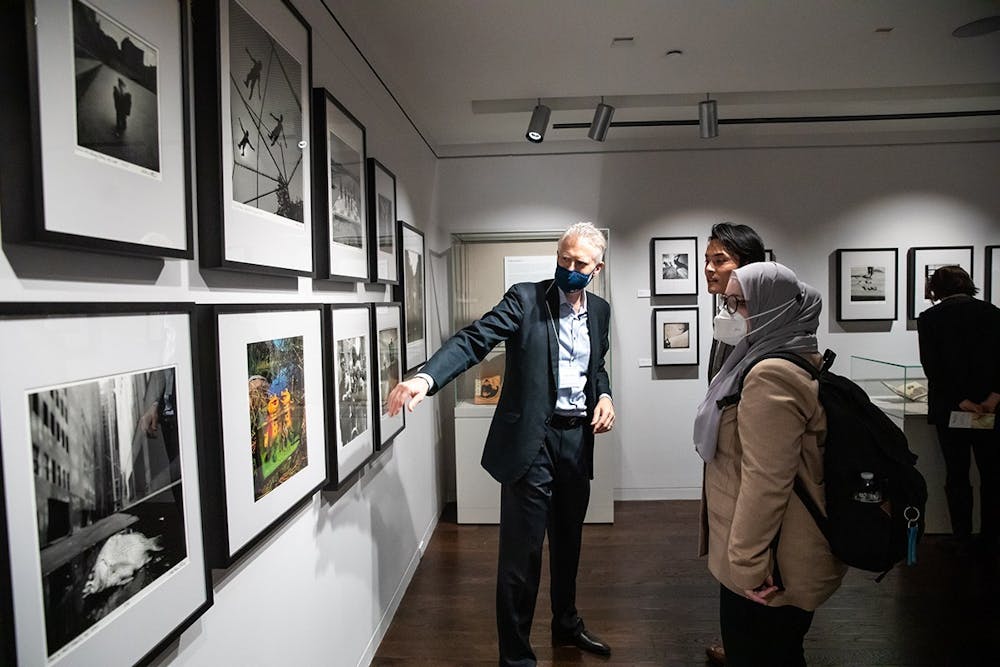
Photographer Arthur Tress's collection of illustrative Japanese books on exhibition in Van Pelt Library along with his photographs (Photo from Monica Fonorow).
Penn Libraries has opened a new exhibition highlighting renowned photographer Arthur Tress’ collection of illustrative Japanese books along with his photographs.
The exhibit — which will be on display until Dec. 16 — features one of the most complete collections of Japanese illustrative books of any North American institution. According to Julie Nelson Davis, a professor of modern Asian art who was one of the main co-curators of the exhibit, it's even larger than the one at the National Museum of Asian Art.
The books displayed in the exhibit vary from titles well-known in Japanese institutions to others that are rare and difficult to find in Japan or the rest of the international community. Along with Davis, the main co-curators of the exhibit were Linda Chance, professor of Japanese studies, and graduate students Eri Mizukane, Nicholas Purgett, and Maria Puzyreva. They were assisted by Kislak Center curators John Pollack and Lynne Farrington.
In 2018, Tress donated his collection of approximately 1,200 titles of Japanese illustration books that he started in 1965 to the Kislak Center after reading Davis’s 2014 book "Partners in Print: Artistic Collaboration and the Ukiyo-e Market."
In the book, Davis discusses the collaborative relationship between illustrative artists and publishers in the Edo period in Japan. Davis explained that in an email exchange with Tress, he told her that the way she examined all parts of the publishing process in the book resonated with him, and convinced him that Davis would be a good advocate for his collection.
Following the donation, Davis taught two curatorial seminars at Penn in 2019 and 2020, where she guided her students through the study of various aspects of Japanese history, art, print cultures, and bookmaking techniques.
Her students participated in a project called “Adopt a Book,” where the students picked a Japanese illustrative book from the Tress collection, researched it, and then made arguments as to whether to include it or not in the exhibition. Additionally, all of the catalog entries about the books in the exhibit were written by the students.
In class at the end of the semester, the students articulated the themes that were present in the books, which the curation team then integrated into the design of the exhibit — as the works in each distinct encasement correspond to a specific theme. For example, different clusters of books pertained to calligraphy, paintings, theater, and other themes.
Mizukane highlighted the harmonious relationship she observes between Tress’ photographs and the books, which she called essentially two exhibits put seamlessly together. She added that photographs allow viewers to see inside Tress’s head and understand where his work comes from.
“It’s kind of really neat because you not only get to see the Japanese illustrative books, which are really great in themselves, but you also get to see the collector’s influence and the collector’s sort of world,” she said.
Puzyreva said that the Tress collection was one of the driving factors that brought her to Penn to study the history of Japanese art, along with the opportunity to work with Davis. Similarly, Purgett said that he switched from studying medieval European art to Japanese art for his Ph.D., partly because of how excited he was to work with the collection.
“If I made this huge leap, I was going to have access to one of the greatest collections, not only in the United States, but, I mean if we’re talking about this, in terms of the availability of the collection, in terms of the span of the collection in the world, and that was enormously exciting,” Purgett said.
For Davis, Tress’ photographs aren’t simply influenced by the Japanese books — he forms his own reality and responses to the world around him through his photographs.
“He is somebody who delights. He’s interested in the world; he’s really curious and is always experimenting in his own photography. It’s just a joy to work with him.”
The Tress collection is not the first collection of Japanese books to be donated to Penn Libraries.
In 2013, Shirley and Marilyn Luber, wife and daughter of the late 1940 Wharton graduate and renowned Philadelphia art collector Gilbert Luber, donated a collection of more than 1,300 books dealing with Japanese art and Japan.
“With this collection, the Penn Library becomes one of the foremost places to conduct research on the art of the Japanese print from past to present and will make it possible for us to teach this material to a new generation,” Davis said at the time in reference to the Luber collection.
Even after the exhibit comes to a close, students will be able to explore the Tress collection by appointment since it will be housed in the Kislak Center for Special Collections, Rare Books and Manuscripts on the sixth floor of Van Pelt library.
The Daily Pennsylvanian is an independent, student-run newspaper. Please consider making a donation to support the coverage that shapes the University. Your generosity ensures a future of strong journalism at Penn.
Donate






